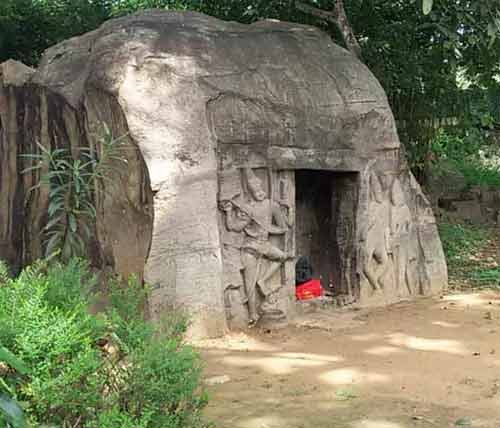Majority of the cave temples in Kerala were built between 6th and 9th century CE. Most of them are very small compared to the popular Hindu cave temples in western parts of India. Here is look at the cave temples in Kerala. The list of popular Guha temples in Kerala is incomplete as there is no final word regarding anything related to Hindu religion as new information and new discoveries are made regularly.
Methala Kallil Cave Temple
Methala Kallil cave temple is an ancient cave temple located at Asamannoor Village in Ernakulam district, Kerala. The temple is around 10 km from Kothamangalam, Perumbavoor and Muvattupuzha. The Bhagavathi Prathishta is in a cave beneath a massive rock (75 feet length, 45 feet width and 25 feet) that stands without a support on the ground – this is a wonder.
Historical studies indicate that the temple dates back to the third century BC. The natural cave temple is located in the middle of a 28 acre forest.
In the beginning it was a Jain Temple as there are murtis of Vardhaman Mahavir, Paarshwanadhan and Padmavathi Devi as deities serves as evidence to this historic piece of information. The place was then abandoned for several hundred years and later the presence of Goddess Bhagavathi was seen in the cave and it became a Hindu temple around 9th century CE.
Once, a group of people went into the dense forest to gather honey, fruits and other edibles and medicines. Here they spotted a beautiful woman juggling with huge boulders. As they approached the woman, she disappeared and covered herself with the boulders. This is how the presence of Kallil Bhagavathi was discovered.
It is said that the huge boulder she threw up became the roof of the temple and the stone that fell down became her seat.
The main festival in the temple is observed on Thrikarthika day in Vrischikam month. Bhagavathi is taken atop a female elephant.
Kallil Bhagavathi is seated to the right of the door of the shrine. There is a Balikkallu in front of the Sreekovil, stone roofed elephant shed, steps made of stones and the temple pond and the oottupura made in stone.
Vizhinjam Cave Temple
Considered to be the smallest rock-cut shrine in southern India, the Vizhinjam Rock-cut cave is dated to back to 8th century.
The shrine has a central cell with an independent sculpture of Dakshinamurthy and on either side of the cell are unfinished sculptures of Siva and Parvathi. It is believed to be one of the earliest rock-cut cave temples in Kerala.
Kottukal Cave Temple
Kottukkal Cave Temple, also known as Kaltrikkovil, built between 6th and 8th centuries CE, is located at Kottukkal, near Anchal, Kollam district, Kerala.
There are two caves of unequal size, both facing east with Ganapathy as the main murti. The smaller cave has a murti of Hanuman. The larger one has a murti of Nandi and a Shivling.
Kaviyoor Trikkukkudi Cave Temple
Kaviyoor cave temple is located on the banks of Manimala River in Pathanamthitta district, Kerala.
The shrine belongs to early 8th century AD. Shivling (three feet high carved out of granite) is enshrined in a square cave. The shrine also has murtis of Ganapathy, Maharishi and Dwarapalakas.
Trikkur Mahadeva Cave Temple
Trikkur Mahadeva Temple is a cave temple in Trikkur village in Thrissur District in Kerala and it is believed to have been built in the 7th or 8th century.
The main deity of this temple is a huge Shivling consecrated by Agni Bhagavan.
The temple sreekovil is located on the top of the hillock inside 30 feet long and 12 feet broad natural cave. The Shivling is at the southern end of the cave, just above this there is a waterhole that never dries even in the hottest days during summers. The shivling faces the east but the door of the Garbhagriha faces north. There is an evergreen pond on the top of the rock.
The entrance to the temple consists of many mantapas and is accessed through a flight of steps.
The Mukha mandapa, in front of the sanctum, is large and is carved fully out of rock. Devotees are allowed only the darshan of the right side of the Shivling.
There is a nada with steps leading to the main shrine and Artha Mantapa. Ganapathy, Sapthamatrika and other shrines are atop the hill and they are approached with separate set of rugged rock steps.
Madavoorpara Cave Temple
A rock-cut Shiva Temple which dates back to the 9th Century CE is located at Madavoorpara around 17 km from Thiruvananthapuram.
Carved out on a steep rock slope are thirteen steps that lead to the square-shaped temple. The cave is carved out on the surface of a bare rock, which has now been protected with iron doors.
Thirunanthikarai
Thirunanthikarai cave temple (Kudaivarai Kovil) probably dates to the 9th century AD and is located in Kanyakumari district, Tamil Nadu. The shrine is dedicated to Shiva and Vishnu.
Currently the Thirunanthikarai Cave Temple is under the purview and care of Archaeological Survey of India. An inscription of Chola king Rajaraja I can be found in the temple. The shrine is around 24 km from Parassala.






